Papers by Charles Michelo
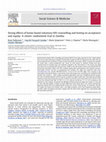
Social Science & Medicine, 2013
Home-based voluntary HIV counselling and testing (HB-VCT) has been reported to have a high uptake... more Home-based voluntary HIV counselling and testing (HB-VCT) has been reported to have a high uptake, but it has not been rigorously evaluated. We designed a model for HB-VCT appropriate for wider scale-up, and investigated the acceptance of home-based counselling and testing, equity in uptake and negative life events with a cluster-randomized trial. Thirty six rural clusters in southern Zambia were pairmatched based on baseline data and randomly assigned to the intervention or the control arm. Both arms had access to standard HIV testing services. Adults in the intervention clusters were offered HB-VCT by local lay counsellors. Effects were first analysed among those participating in the baseline and postintervention surveys and then as intention-to-treat analysis. The study was registered with www. controlled-trials.com, number ISRCTN53353725. A total of 836 and 858 adults were assigned to the intervention and control clusters, respectively. In the intervention arm, counselling was accepted by 85% and 66% were tested (n ¼ 686). Among counselled respondents who were cohabiting with the partner, 62% were counselled together with the partner. At follow-up eight months later, the proportion of adults reporting to have been tested the year prior to follow-up was 82% in the intervention arm and 52% in the control arm (Relative Risk (RR) 1.6, 95% CI 1.4e1.8), whereas the RR was 1.7 (1.4e2.0) according to the intention-to-treat analysis. At baseline the likelihood of being tested was higher for women vs. men and for more educated people. At follow-up these differences were found only in the control communities. Measured negative life events following HIV testing were similar in both groups. In conclusion, this HB-VCT model was found to be feasible, with a very high acceptance and to have important equity effects. The high couple counselling acceptance suggests that the home-based approach has a particularly high HIV prevention potential.
Health Research Policy and Systems, 2014
Background: Priority-setting decisions are based on an important, but not sufficient set of value... more Background: Priority-setting decisions are based on an important, but not sufficient set of values and thus lead to disagreement on priorities. Accountability for Reasonableness (AFR) is an ethics-based approach to a legitimate and fair priority-setting process that builds upon four conditions: relevance, publicity, appeals, and enforcement, which facilitate agreement on priority-setting decisions and gain support for their implementation. This paper focuses on the assessment of AFR within the project REsponse to ACcountable priority setting for Trust in health systems (REACT).

Medical Teacher, 2014
Abstract Background: Research outputs in sub-Saharan Africa may be limited by a scarcity of clini... more Abstract Background: Research outputs in sub-Saharan Africa may be limited by a scarcity of clinical research expertise. In Zambia, clinical and biomedical postgraduate students are often delayed in graduation due to challenges in completing their research dissertations. We sought to strengthen institutional research capacity by supporting student and faculty researchers through weekly epidemiology and biostatistics clinics. Methods: We instituted a weekly Analytical Support Clinic at the University of Zambia, School of Medicine. A combination of biostatisticians, clinical researchers and epidemiologists meet weekly with clients to address questions of proposal development, data management and analysis. Clinic sign-in sheets were reviewed. Results: 109 students and faculty members accounted for 197 visits to the Clinic. Nearly all clients (107/109, 98.2%) were undergraduate or postgraduate students. Reasons for attending the Clinic were primarily for proposal development (46.7%) and data management/analysis (42.1%). The most common specific reasons for seeking help were data analysis and interpretation (36.5%), development of study design and research questions (26.9%) and sample size calculation (21.8%). Conclusions: The Analytical Support Clinic is an important vehicle for strengthening postgraduate research through one-on-one and small group demand-driven interactions. The clinic approach supplements mentorship from departmental supervisors, providing specific expertise and contextual teaching.
Medical Journal of Zambia, 2007
Malaria Journal, 2015
Background: Malaria continues to be a major health problem in low-income countries. Consequently,... more Background: Malaria continues to be a major health problem in low-income countries. Consequently, malaria control remains a public health priority in endemic countries such as Zambia. Pregnant women and children under 5 years of age are among groups at high risk of malaria infection. Malaria infection is associated with adverse birth outcomes that affect the mother, foetus, and infant. Infection with HIV has been shown to increase the risk of malaria infection in pregnancy. The prevalence and the predictors of malaria infection among pregnant women resident in the Nchelenge District of northern Zambia were investigated.
Medical journal of Zambia
Background: Exclusive breastfeeding practice in high prevalence settings remains a challenge beca... more Background: Exclusive breastfeeding practice in high prevalence settings remains a challenge because of likelihood of HIV transmission through breast milk.
Medical journal of Zambia
To determine the proportion of and factors associated with home deliveries in Nchelenge district,... more To determine the proportion of and factors associated with home deliveries in Nchelenge district, Zambia.
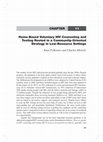
The number of new HIV infections has declined globally since the late 1990s. Despite progress, th... more The number of new HIV infections has declined globally since the late 1990s. Despite progress, the pandemic is far from under control, least of all in parts of Africa where extremely serious epidemics continue to have disastrous social and economic impact. The Millennium Development Goals (MDGs) were adopted by United Nations (UN) member states in 2000, and these included targets on HIV that were later updated to be the targets set by 2015: (a) 50% reduction in sexual and parenteral HIV transmis-sion, (b) to eliminate vertical HIV transmission, (c) 50% reduction of tuberculosis (TB) deaths among people with HIV, and (d) deliver antiretroviral therapy (ART) to 15 million people. Despite the reduction in new people being infected by HIV, new infections outnumber those receiving treatment (Hallett et al., 2009) and there is no way these targets can be achieved unless individuals at risk of HIV learn their status and are linked to preventive, support, and treatment services. Despite hea...
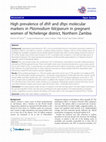
Malaria Journal, 2015
Background: Sulphadoxine-pyrimethamine (SP) is the recommended drug for intermittent preventive t... more Background: Sulphadoxine-pyrimethamine (SP) is the recommended drug for intermittent preventive treatment in pregnancy (IPTp) in most African countries, including Zambia. However, malaria is still one of the leading causes of morbidity and mortality in pregnant women despite reports of greater than 50% of women taking at least two doses of SP in IPTp. Studies have shown that resistance to SP is associated with mutations in the dhfr and dhps gene of Plasmodium falciparum. This study examined the prevalence of dhfr and dhps polymorphisms in P. falciparum found in pregnant women of Nchelenge district. Method: This cross-sectional study was conducted in 2013 in Nchelenge, a holoendemic area with malaria prevalence estimated at 50% throughout the year. Three rural health centres were randomly selected and a census survey carried out at each health centre. A questionnaire was administered and malaria testing done using RDT and microscopy, with collection of a dried blood spot. A chelex extraction was done to extract parasite DNA from dried blood spots followed by nested PCR and enzyme restriction digestion. Results: Of the enrolled participants (n = 375), the median age of the women was 23. The prevalence of malaria by PCR was 22%. The PCR positive samples examined (n = 72) showed a high prevalence of dhfr triple (Asn-108 + Arg-59 + Ile-59) mutant (68%) and dhps double (Gly -437 + Glu-540) mutant (21%). The quintuple haplotype was found in 17% with 2 samples with an additional Gly-581mutation. In addition 6% mutations at Val-16 were found and none found at Thr-108 respectively, these both confer resistance to cycloguanil. Multivariate analysis showed that there was an association between malaria and women aged 30-34 years old p < 0.05(AOR: 0.36) at 95% CI. Conclusion: This study showed a high number of mutations in the dhfr and dhps genes. The high malaria endemicity in the general population of this area may have contributed to the high prevalence of resistant parasites in pregnant women, suggesting a need to examine the efficacy of SP given that it is the only approved drug for IPTp in Zambia.
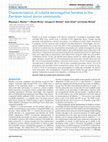
Frontiers in Public Health, 2015
Rubella is an acute, contagious viral infection caused by a teratogenic enveloped singlestranded ... more Rubella is an acute, contagious viral infection caused by a teratogenic enveloped singlestranded RNA virus, rubella virus, a member of the togaviridae family. Though causing generally mild infections in children and adults, it is a disease of public health importance in pregnant women causing major problems including abortions, miscarriages, and congenital rubella syndrome in more than 20% of the susceptible population. This study was carried out to determine the characteristics associated with rubella seronegativity among female blood donors in Zambia. Rubella-specific IgG antibody levels were measured in the blood serum. Proportions were compared using the Chi-squared test at the 5% significance level, and magnitudes of associations were determined using the odds ratio and its 95% confidence interval. Of the 124 female blood donors tested for rubella IgG 46.0% were aged <20 years. Overall, 66.7% of the participants had never been married. More than half (62.1%) of the participants resided in rural areas of the country. Of the 114 participants with recorded level of education, 50.1% had at least completed secondary school. Out of 43 participants with recorded current employment status, 44.2% were not working for pay. A total of 10 (8.1%) participants were seronegative to rubella IgG antibodies. No factors were associated with seronegativity. Protection against rubella through natural infection appears inadequate to protect the population, increasing the risk of CRS.
Malaria Journal, 2015
Background: The resistance of malaria parasites to sulphadoxine-pyrimethamine (SP) in 2007 led to... more Background: The resistance of malaria parasites to sulphadoxine-pyrimethamine (SP) in 2007 led to the Malawi Ministry of Health changing to artemether-lumefantrine (AL) as first-line for uncomplicated malaria treatment. This study determined the efficacy and safety of AL for the treatment of uncomplicated Plasmodium falciparum malaria among six to 59 months old Malawian children.
African Journal of Primary Health Care & Family Medicine, 2015
Background: Involving all relevant healthcare providers in tuberculosis (TB) management through p... more Background: Involving all relevant healthcare providers in tuberculosis (TB) management through public-private mix (PPM) approaches is a vital element in the World Health Organization's (WHO) Stop TB Strategy. The control of TB in Zambia is mainly done in the public health sector, despite the high overall incidence rates.

Pan African Medical Journal, 2015
Neonatal mortality accounts for almost 40 percent of under-five child mortality globally and this... more Neonatal mortality accounts for almost 40 percent of under-five child mortality globally and this could be associated with a complex chain of factors including but not limited to socio-economic, biological and healthcare-related factors. We examined factors that may be associated with neonatal mortality in Zambia. Using across-sectional design, data were extracted from the 2007 Zambia Demographic and Health Survey for women using a &amp;amp;quot;Women&amp;amp;#39;s Questionnaire&amp;amp;quot; for respondents aged 15-49 years in the selected households. Records of women who reported having given birth to live infants within the five years preceding the survey defined the study population. However only records on those infants who could have lived through the first month (28 days) were assessed (de facto population). Overall (n=6 435), there were 3204(49.8%) males and 3231(50.2%)females. There were 219 (3.4%) neonatal deaths recorded. Low birth weight and overweight were reported as the prominent factors. The odds of dying were significantly higher for infants with low birth weight compared to infants born with normal weight, (aOR=2.58, 95%CI 1.02-6.49). The pattern was the same in both rural though insignificant. Over weight born babies showed increased odds of dying (aOR 3.21, 95%CI 1.36-7.59). Compared to infants born from Mothers with no education, infants born from mothers with higher education were associated with increased odds of dying (aOR 3.55, CI 95%, 1.26-9.94). Neonatal survival is still a challenge in this population and determinants show varying socio-demographic contrasts. This may suggest limitations in past efforts to improve neonatal health. Future strategies need to continue but should account for varying setting specific epidemiological contrasts.
Human Resources for Health, 2014
In order to address the challenges facing the community-based health workforce in Zambia, the Min... more In order to address the challenges facing the community-based health workforce in Zambia, the Ministry of Health implemented the national community health assistant strategy in 2010. The strategy aims to address the challenges by creating a new group of workers called community health assistants (CHAs) and integrating them into the health system. The first group started working in August 2012. The objective of this paper is to document their motivation to become a CHA, their experiences of working in a rural district, and how these experiences affected their motivation to work.
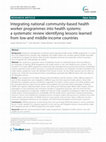
BMC Public Health, 2014
Background: Despite the development of national community-based health worker (CBHW) programmes i... more Background: Despite the development of national community-based health worker (CBHW) programmes in several low-and middle-income countries, their integration into health systems has not been optimal. Studies have been conducted to investigate the factors influencing the integration processes, but systematic reviews to provide a more comprehensive understanding are lacking. Methods: We conducted a systematic review of published research to understand factors that may influence the integration of national CBHW programmes into health systems in low-and middle-income countries. To be included in the study, CBHW programmes should have been developed by the government and have standardised training, supervision and incentive structures. A conceptual framework on the integration of health innovations into health systems guided the review. We identified 3410 records, of which 36 were finally selected, and on which an analysis was conducted concerning the themes and pathways associated with different factors that may influence the integration process.
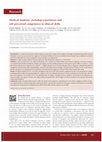
African Journal of Health Professions Education, 2014
In a traditional curriculum, medical students are expected to acquire clinical competence through... more In a traditional curriculum, medical students are expected to acquire clinical competence through the apprenticeship model using the Halstedian 'see one, do one, and teach one' approach. The School of Medicine, University of Zambia, Lusaka, Zambia, used a traditional curriculum model from 1966 until 2011, when a competence-based curriculum was implemented. Objective. To explore medical students' clerkship experiences and self-perceived competence in clinical skills. Methods. A cross-sectional survey was conducted among 5th-, 6th-, and 7th-year medical students at the School of Medicine, University of Zambia, two months before the final examinations. Students were asked to rate their clerkship experiences with regard to specific skills on a scale of 1 -4 and their level of self-perceived competence on a scale of 1 -3. Skills evaluated were in four main domains: history-taking and communication, physical examination and procedural skills, professionalism, teamwork and medical decision-making. Using the Statistical Package for the Social Sciences (SPSS), correlations were performed between experiences and self-perceived competence of specific skills, within domains and overall. Results. Of clinical students (N=197), 138 (70%) participated in the survey. The results showed a significant increase in the proportion of students performing different skills and reporting feeling very competent with each additional clinical year. Overall correlations between experience and selfperceived competence were moderate (0.55). For individual skills, the highest correlation between experience and self-perceived competence was observed mainly with regard to medical-and surgical-related procedural skills, with the highest at 0.82 for nasogastric tube insertion and 0.76 for endotracheal intubation. Conclusion. Despite the general improvement in skills and self-perceived competence some deficiencies were noted, as significant numbers of finalyear students had never attempted important common procedures, especially those performed in emergency situations. Deficiencies in certain skills may call for the incorporation of teaching/learning methods that broaden students' exposure to such skills. AJHPE 2014;6(2):155-160.
Medical Journal of Zambia, 2010
BMC Health Services Research, 2015
Background: To address the huge human resources for health gap in Zambia, the Ministry of Health ... more Background: To address the huge human resources for health gap in Zambia, the Ministry of Health launched the National Community Health Assistant Strategy in 2010. The strategy aims to integrate community-based health workers into the health system by creating a new group of workers, called community health assistants (CHAs). However, literature suggests that the integration process of national community-based health worker programmes into health systems has not been optimal. Conceptually informed by the diffusion of innovations theory, this paper qualitatively aimed to explore the factors that shaped the acceptability and adoption of CHAs into the health system at district level in Zambia during the pilot phase.
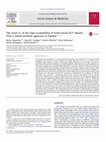
Social Science & Medicine, 2013
HIV testing and counselling is a critical gateway to prevention and treatment. Yet, coverage rema... more HIV testing and counselling is a critical gateway to prevention and treatment. Yet, coverage remains insufficient, few couples are tested together and gender differences in access exist. We used an embedded mixed methods approach to investigate possible explanations for the high acceptance of home-based voluntary HIV counselling and testing (HB-VCT) in a pair-matched cluster-randomized trial in Zambia. A baseline survey included 1694 individuals in 36 clusters. Adults in 18 intervention clusters were offered HB-VCT by lay counsellors. Standard testing services were available in both trial arms. After the completion of the intervention, a follow-up survey was conducted in all trial clusters. In addition, 21 in-depth interviews and one focus group discussion were conducted with home-based VCT clients in the intervention arm. Informants favoured the convenience, confidentiality and credibility of HB-VCT. Counsellors were perceived as trustworthy owing to their closeness and conduct, and the consent process was experienced as convincing. Couple testing was selected by 70% of cohabiting couples and was experienced as beneficial by both genders. Levels of first-time testing (68% vs. 29%, p < 0.0001) and re-testing (94% vs. 74%, p < 0.0001) were higher in the intervention than in the control arm. Acceptance of HIV testing and counselling is dependent on stigma, trust and gender. The confidentiality of homebased VCT was essential for overcoming stigma-related barriers, and the selection of local counsellors was important to ensure trust in the services. The high level of couple counselling within HB-VCT may contribute to closing the gender gap in HIV testing, and has benefits for both genders and potentially for prevention of HIV transmission. The study demonstrates the feasibility of achieving high test coverage with an opt-in consent approach. The embedded qualitative component confirmed the high satisfaction with HB-VCT reported in the quantitative survey and was crucial to fully understand the intervention and its consequences.




Uploads
Papers by Charles Michelo